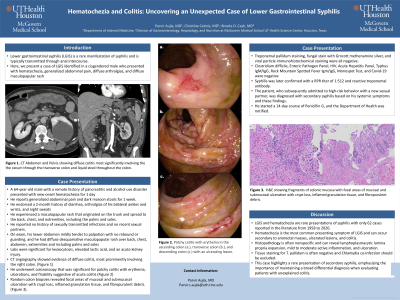Monday Poster Session
Category: Colon
P2063 - Hematochezia and Colitis: Uncovering an Unexpected Case of Lower Gastrointestinal
Monday, October 28, 2024
10:30 AM - 4:00 PM ET
Location: Exhibit Hall E

Has Audio

Parvir Aujla, MD
University of Texas Health, McGovern Medical School
Houston, TX
Presenting Author(s)
Parvir Aujla, MD1, Christine Catinis, MD2, Brooks D. Cash, MD, FACG3
1University of Texas Health, McGovern Medical School, Houston, TX; 2University of Texas at Houston, Houston, TX; 3McGovern Medical School at UTHealth, Houston, TX
Introduction: Lower gastrointestinal syphilis (LGIS) is a rare manifestation of syphilis and is typically transmitted through anal intercourse. Here, we present a case of LGIS identified in a cisgendered male who presented with hematochezia, generalized abdominal pain, diffuse arthralgias, and diffuse maculopapular rash.
Case Description/Methods: A 64-year-old male with a remote history of pancreatitis and alcohol use disorder presented with new-onset hematochezia for 1 day and generalized abdominal pain and dark maroon stools for 1 week. In addition, he endorsed a 2-month history of diarrhea, arthralgias of his bilateral ankles and wrists, night sweats, and maculopapular rash that originated on the trunk and spread to the back, chest, and extremities, including the palms and soles. He reported no history of sexually transmitted infections and no recent sexual partners. CT angiography showed evidence of diffuse colitis, most prominently involving the right colon. He underwent colonoscopy that was significant for patchy colitis with erythema, ulcerations, and friability suggestive of acute colitis (Figure 1). Random colon biopsies revealed focal areas of mucosal and submucosal ulceration with crypt loss, inflamed granulation tissue, and fibropurulent debris.
Treponemal pallidum staining, fungal stain with Grocott methenamine silver, and viral particle immunohistochemical staining were all negative. Syphilis was later confirmed with a RPR titer of 1:512 and reactive treponemal antibody. The patient, who subsequently admitted to high-risk behavior with a new sexual partner, was diagnosed with secondary syphilis based on his systemic symptoms and these findings. He started a 14-day course of Penicillin G, and the Department of Health was notified.
Discussion: LGIS and hematochezia are rare presentations of syphilis with only 62 cases reported in the literature from 1958 to 2020. Hematochezia is the most common presenting symptom of LGIS and can occur secondary to anorectal masses, ulcerated lesions, and colitis. Histopathology is often nonspecific and can reveal lymphoplasmacytic lamina propria expansion, mild to moderate active inflammation, and ulceration. Tissue staining for T. pallidum is often negative and Chlamydia co-infection should be excluded. This case highlights a rare presentation of secondary syphilis, emphasizing the importance of maintaining a broad differential diagnosis when evaluating patients with unexplained colitis.

Disclosures:
Parvir Aujla, MD1, Christine Catinis, MD2, Brooks D. Cash, MD, FACG3. P2063 - Hematochezia and Colitis: Uncovering an Unexpected Case of Lower Gastrointestinal, ACG 2024 Annual Scientific Meeting Abstracts. Philadelphia, PA: American College of Gastroenterology.
1University of Texas Health, McGovern Medical School, Houston, TX; 2University of Texas at Houston, Houston, TX; 3McGovern Medical School at UTHealth, Houston, TX
Introduction: Lower gastrointestinal syphilis (LGIS) is a rare manifestation of syphilis and is typically transmitted through anal intercourse. Here, we present a case of LGIS identified in a cisgendered male who presented with hematochezia, generalized abdominal pain, diffuse arthralgias, and diffuse maculopapular rash.
Case Description/Methods: A 64-year-old male with a remote history of pancreatitis and alcohol use disorder presented with new-onset hematochezia for 1 day and generalized abdominal pain and dark maroon stools for 1 week. In addition, he endorsed a 2-month history of diarrhea, arthralgias of his bilateral ankles and wrists, night sweats, and maculopapular rash that originated on the trunk and spread to the back, chest, and extremities, including the palms and soles. He reported no history of sexually transmitted infections and no recent sexual partners. CT angiography showed evidence of diffuse colitis, most prominently involving the right colon. He underwent colonoscopy that was significant for patchy colitis with erythema, ulcerations, and friability suggestive of acute colitis (Figure 1). Random colon biopsies revealed focal areas of mucosal and submucosal ulceration with crypt loss, inflamed granulation tissue, and fibropurulent debris.
Treponemal pallidum staining, fungal stain with Grocott methenamine silver, and viral particle immunohistochemical staining were all negative. Syphilis was later confirmed with a RPR titer of 1:512 and reactive treponemal antibody. The patient, who subsequently admitted to high-risk behavior with a new sexual partner, was diagnosed with secondary syphilis based on his systemic symptoms and these findings. He started a 14-day course of Penicillin G, and the Department of Health was notified.
Discussion: LGIS and hematochezia are rare presentations of syphilis with only 62 cases reported in the literature from 1958 to 2020. Hematochezia is the most common presenting symptom of LGIS and can occur secondary to anorectal masses, ulcerated lesions, and colitis. Histopathology is often nonspecific and can reveal lymphoplasmacytic lamina propria expansion, mild to moderate active inflammation, and ulceration. Tissue staining for T. pallidum is often negative and Chlamydia co-infection should be excluded. This case highlights a rare presentation of secondary syphilis, emphasizing the importance of maintaining a broad differential diagnosis when evaluating patients with unexplained colitis.

Figure: Figure 1: Patchy colitis with erythema in the ascending colon (a.), transverse colon (b.), and descending colon (c.) with an ulcerating lesion.
Disclosures:
Parvir Aujla indicated no relevant financial relationships.
Christine Catinis indicated no relevant financial relationships.
Brooks Cash: Abbvie – Consultant, Speakers Bureau. Alnylam – Speakers Bureau. Ardelyx – Consultant, Speakers Bureau. Astra Zeneca – Consultant, Speakers Bureau. Phathom – Consultant, Speakers Bureau. QOL – Speakers Bureau. Salix – Speakers Bureau. Vibrant Advisory Board – Advisory Committee/Board Member.
Parvir Aujla, MD1, Christine Catinis, MD2, Brooks D. Cash, MD, FACG3. P2063 - Hematochezia and Colitis: Uncovering an Unexpected Case of Lower Gastrointestinal, ACG 2024 Annual Scientific Meeting Abstracts. Philadelphia, PA: American College of Gastroenterology.
